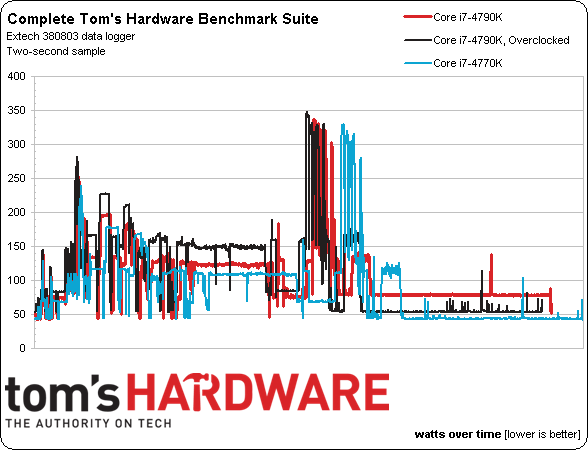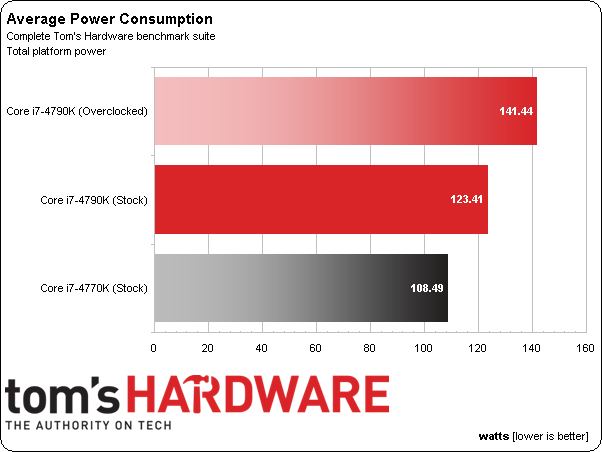Core i7-4790K Review: Devil's Canyon Tantalizes Enthusiasts
Despite a clear performance advantage, Intel just doesn't seem like an enthusiast-friendly company. Certain elements in the organization want to change that perception, though. Devil's Canyon is meant to allay power users with more speed.
Results: Power Consumption
The following chart reflects power consumption throughout our benchmark suite, which gets logged every two seconds. The long, straight section at the end represents 30 minutes of idle time inserted by our automated script to better reflect actual use when we calculate averages.
It's pretty clear that going from Core i7-4770K to -4790K increases power consumption under load. That much we expected. More strange is that the stock Core i7-4790K doesn't settle into the same idle state as the stock -4770K (or even the overclocked -4790K, which does drop down around 50 W). It's possible that MSI's Z97 Gaming 7 motherboard isn't properly dropping into the right C-state by default, correcting the behavior only when we overclock manually. We'll take this into account as we present the next chart, though.
The other observation we make is that consumption rises noticeably once we apply more voltage and a higher clock rate to the Core i7-4790K. No surprise there. Let's have a look at how average use is affected.
The above chart includes a couple-thousand data points averaged together for each CPU. I specifically factored out the idle time, though, due to the obvious anomaly suffered by the stock Core i7-4790K. We'll keep things fair and stop short of running efficiency numbers. But when these CPUs are churning through our scripted benchmark sequences (all of the applications presented on the preceding pages), you can see how big of a difference there is between them. Overclocking takes the Core i7-4790K up an extra 20 W, on average. And that's on top of a 15 W increase going from stock Core i7-4770K to -4790K.
Of course, these are still systems with 16 GB of DDR3 memory and a GK110-powered GeForce GTX Titan. Power consumption is hardly what we'd call egregious.
Get Tom's Hardware's best news and in-depth reviews, straight to your inbox.
Current page: Results: Power Consumption
Prev Page Results: Compression Apps Next Page Core i7-4790K Adds Enthusiast Appeal To Haswell-
NBSN Really nice read. I am very excited to see how well the i7-4790k performed, and that means in 2-3 years the CPUs that will be out are going to be amazing. It will be nice to start seeing stock clocked 4 GHz to 4.5 GHz Intel CPUs to better keep up with the AMD overclocking that many builders do. I prefer Intel and really feel that they offer the best performance for their CPUs.Reply
I built my PC at the end of last year, beginning of this one and went with a i7-4930k. I really wanted a six core processor and have not been disappointed. I have been itching to build another PC because it was really fun to put the plan of components together and although my hands were to big and my medical conditions prevented me from getting to do a lot of the building, my wife helped a lot with that part and it was nice to see the finished product in action. With that being said, I don't have a lot of money for anything right now and hope that my disability pay finally comes through so I can start picking together parts for a computer for my wife. She won't need anything as powerful as I have, and the i7-4790k sounds pretty sweet. -
BoredErica The average overclock based upon my Google Doc of about 185 overclocks now averages at 4.55ghz for Haswell. A tim change isn't going to gain an extra 200mhz and even then, it's being generous.Reply
On a side note, this website annoys me. I click to add comment and the default fields are for signing up, no logging in, and when I do, I am back to the homepage. Great. -
roymustang It would've been nice to show benchmarks and temps vs sandy bridge (2600K) at same frequency to help us gauge the progress (or the lack of) that's been made in the last three and a half years.Reply -
neon neophyte so one of their biggest selling points ended up resulting in a 6 degree difference.Reply
bring back solder intel. -
Amdlova nice improve :) please where i put my razor? no way 6ºc improve. my ambient temp hits 45ºc my old 3770k 4.6ghz hit 88ºc on core. with this "new shinning old tech" i can't hit the 4.2ghz. intel miss and miss Hard!Reply -
NBSN I think that the whole real point of releasing this new processor and the others to follow it is simple. Intel wants to offer a better stock clock for those that do not want to or do not know how to overclock their processor. And since AMD allows easier overclocking, or at least a whole lot more processors that can be overclocked than the ones that Intel specifies for their own products. This will help a lot of consumers decide Intel over AMD if they continue to offer comparative clocks.Reply -
ssdpro First problem: 6C between the old and new TIM is something, but not much. As one of the big improvement features, that is disappointing.Reply
Second problem: Why is Tom's using 1.275 V for 4200MHz on both units? Is that actually 1.275v with LLC disabled or is LLC on a setting resulting in the lowest load voltage? If one of those units need 1.275v to be stable at 4200 you have a real donkey sample on your hands. Even the worst i7-4770k are stable at 1.20v @ 4200. Or was the over voltage designed to test an unrealistic incompetent situation to either emphasize or DE-emphasize the TIM difference? -
Adroid Sorry, but I'm entirely unimpressed. Improved TIM is a waste of time. I thought this was going to release with fluxless solder. 6° worth the wait ? 6° is the difference between air cooling and water cooling.Reply
Voltage wall is still at the approximate same place. Heat is still the limiting factor. I expect some of the better binned 4670K will hit equal or better than the 4690K.
I'll stay with my 3570K @ 4.3ghz - this clearly isn't much of a step up. Looks like I'm waiting for a DDR4 system in a couple years.


